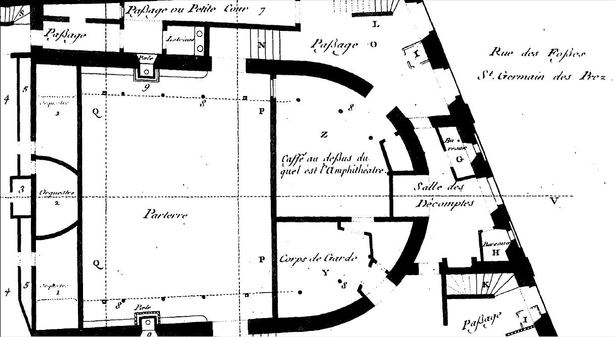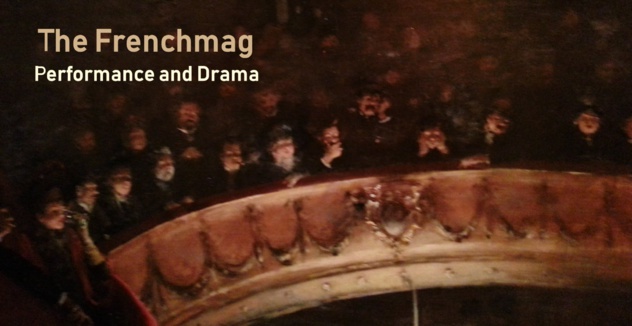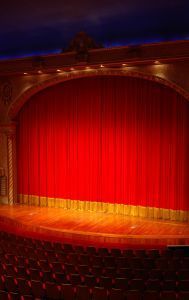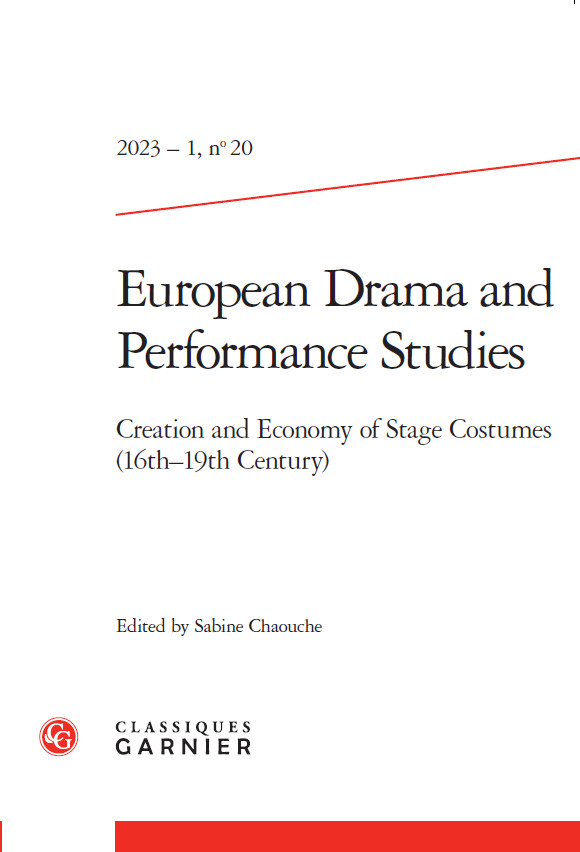
Plan du rez-de-chaussée d'après le plan Blondel.
Archival documents from the Comédie-Française refer most generally to the living environment, i.e. to necessary expenditures to maintain the building in good condition or to ensure a smooth day to day running of the playhouse.
In his two Mémoire des Ouvrages de peinture faits pour Messieurs les Comédiens ordinaires du roy en leur hôtel à Paris, Cayeux, painter and gilder rue des Cordeliers, described the colours used to refresh the building. They were meticulously noted and thus give us an overview of the environment in which the actors evolved, especially rue des Fossés-Saint-Germain des prés: the windows of the foyer were blue and yellow; shutters were daffodil yellow as well as Grandval and Paulin’s dressing rooms (in 1788 Larive chose a red colour for his dressing-room at the Odéon); the walls of the courtyard were white and so was the gate. Walls and ceilings were white and skirting boards were slate grey. The interior of the auditorium was green and yellow (green was frequently used on stage at the time proving that the colour green being taboo in a playhouse is a modern myth). The company chose to create a lively environment which matched the costumes and scenery which were predominantly red, golden, or green as shown in the bills sent by Brunetti.
Archives also offer detailed descriptions of the building, in particular its colours, dimensions, architecture. In February 1767 the company received a memoir from the builder Simon which described all the work which had been done in the playhouse such as for instance the complete refurbishment of the lavatories called cabinets d’aisance which included several seats and repairs to the floor of the cabinet de la pissotière (presumably the gents), or the way in which they emptied the cesspit. In 1768 the walls of the cabinet d’aisance were covered with damask and were decorated by pictures.
Archival material also tell of the different problems actors had to face such as damage by mice or rats (many holes in the walls had to be filled).
Various works relating to heating suggest that the company chose to modernise its equipment: a fireplace was replaced by an earthenware stove in Preville’s dressing room (according to Daniel Roche, stoves were quite new at the time and a sign of progress; it became popular in the 1750s ). Actually two more stoves were used in the playhouse, in the auditorium. One was bought in 1757 (18 liv.) and another one in 1762 (18 liv.).
Members of the audience buying box tickets would be supplied with foot heaters (chaufferettes) during cold seasons.
We also know more about water supplier at the Comédie-Française: actors had an adjoining well, rue des Mauvais-Garçons (second entrance in the back of the playhouse) and various pumps installed within the playhouse to tackle fires (big tanks were in the roof and various barrels on top of the flies). Firemen were also employed during performances. A shop and a refreshment area were located by the entrance on the ground floor. As we can see, actors tried to provide to the audience with a comfortable and even luxurious environment. The Comédie-Française offered different types of services to spectators, and linked entertainment to consumption by providing drinks and goods such as for instance printed plays (not bound books).
In Le Censeur dramatique, Alexandre Grimod de La Reynière explained in the 1790s how important consumption was to the café owner: at the end of each act, when the last line was said, waitresses would enter the auditorium and would shout loudly: “barley water, lemonade, Bavarois, sweets, marrons glacés! ” The company benefitted from this consumption and encouraged it within the playhouse. According to Jules Bonnassiés in his Histoire administrative de la Comédie-Française, Chouquet de Saint-Germain, rent the café area 1,000 liv. per year in 1704. On 7 September 1716, prices went up: Procope had to pay 1,200 liv. per year (he gave it up in 1727).
Theatrical productions were therefore linked to consumption: the Comédie-Française provided services to its customers taking into consideration the need for comfort. In the meantime, it had running costs and bought objects or required services for the maintenance of the building or for stage-productions. The actors were themselves consumers and at the same providers and producers.
Sabine Chaouche
In his two Mémoire des Ouvrages de peinture faits pour Messieurs les Comédiens ordinaires du roy en leur hôtel à Paris, Cayeux, painter and gilder rue des Cordeliers, described the colours used to refresh the building. They were meticulously noted and thus give us an overview of the environment in which the actors evolved, especially rue des Fossés-Saint-Germain des prés: the windows of the foyer were blue and yellow; shutters were daffodil yellow as well as Grandval and Paulin’s dressing rooms (in 1788 Larive chose a red colour for his dressing-room at the Odéon); the walls of the courtyard were white and so was the gate. Walls and ceilings were white and skirting boards were slate grey. The interior of the auditorium was green and yellow (green was frequently used on stage at the time proving that the colour green being taboo in a playhouse is a modern myth). The company chose to create a lively environment which matched the costumes and scenery which were predominantly red, golden, or green as shown in the bills sent by Brunetti.
Archives also offer detailed descriptions of the building, in particular its colours, dimensions, architecture. In February 1767 the company received a memoir from the builder Simon which described all the work which had been done in the playhouse such as for instance the complete refurbishment of the lavatories called cabinets d’aisance which included several seats and repairs to the floor of the cabinet de la pissotière (presumably the gents), or the way in which they emptied the cesspit. In 1768 the walls of the cabinet d’aisance were covered with damask and were decorated by pictures.
Archival material also tell of the different problems actors had to face such as damage by mice or rats (many holes in the walls had to be filled).
Various works relating to heating suggest that the company chose to modernise its equipment: a fireplace was replaced by an earthenware stove in Preville’s dressing room (according to Daniel Roche, stoves were quite new at the time and a sign of progress; it became popular in the 1750s ). Actually two more stoves were used in the playhouse, in the auditorium. One was bought in 1757 (18 liv.) and another one in 1762 (18 liv.).
Members of the audience buying box tickets would be supplied with foot heaters (chaufferettes) during cold seasons.
We also know more about water supplier at the Comédie-Française: actors had an adjoining well, rue des Mauvais-Garçons (second entrance in the back of the playhouse) and various pumps installed within the playhouse to tackle fires (big tanks were in the roof and various barrels on top of the flies). Firemen were also employed during performances. A shop and a refreshment area were located by the entrance on the ground floor. As we can see, actors tried to provide to the audience with a comfortable and even luxurious environment. The Comédie-Française offered different types of services to spectators, and linked entertainment to consumption by providing drinks and goods such as for instance printed plays (not bound books).
In Le Censeur dramatique, Alexandre Grimod de La Reynière explained in the 1790s how important consumption was to the café owner: at the end of each act, when the last line was said, waitresses would enter the auditorium and would shout loudly: “barley water, lemonade, Bavarois, sweets, marrons glacés! ” The company benefitted from this consumption and encouraged it within the playhouse. According to Jules Bonnassiés in his Histoire administrative de la Comédie-Française, Chouquet de Saint-Germain, rent the café area 1,000 liv. per year in 1704. On 7 September 1716, prices went up: Procope had to pay 1,200 liv. per year (he gave it up in 1727).
Theatrical productions were therefore linked to consumption: the Comédie-Française provided services to its customers taking into consideration the need for comfort. In the meantime, it had running costs and bought objects or required services for the maintenance of the building or for stage-productions. The actors were themselves consumers and at the same providers and producers.
Sabine Chaouche




